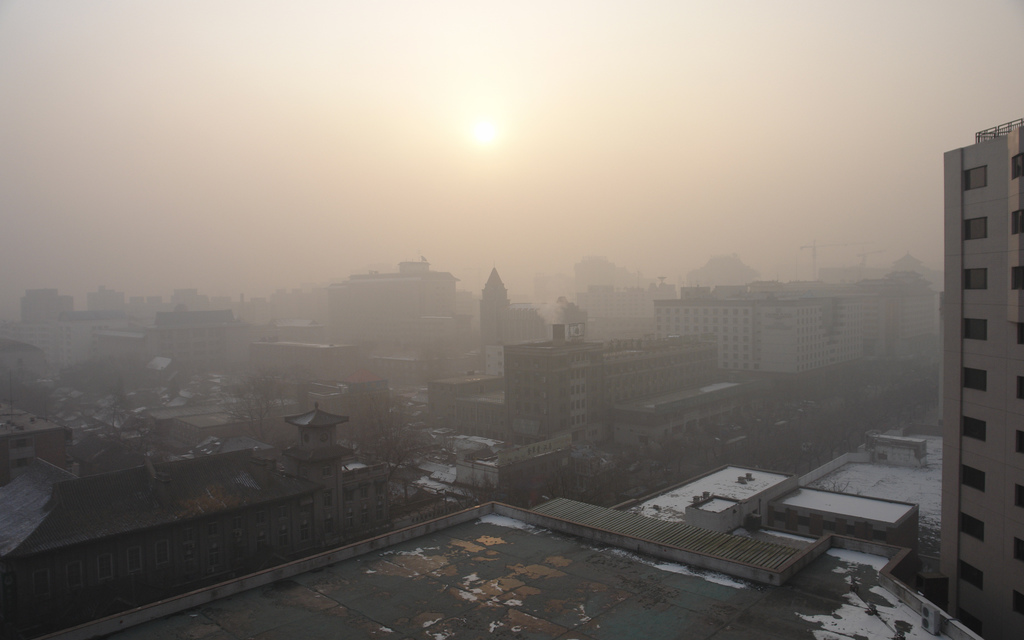Yesterday, a federal appeals court in Washington, D.C., issued a major blow to efforts to curb air pollution. A lower court last year struck down the EPA’s cross-state air pollution rule, and the appeals court declined to reconsider the case. The rule aimed to reduce air pollution that travels from one state to another, a situation that limits the ability of the polluted state to take action against polluters.
The problem is perhaps best illustrated by what’s now happening in China. Today in Beijing, the air quality is “unhealthy,” according to the automatic sensor atop the U.S. embassy. Two weeks ago, it was five times worse, drawing the world’s attention to a problem that had become literally visible in the Chinese capital. This is what the air looked like two days ago, on Wednesday, as the country’s legislature held its annual meeting.
Beijing chokes on smog amid annual legislative sessions.t.cn/zYhNRSu twitter.com/XHNews/status/…
— Xinhua News Agency (@XHNews) January 23, 2013
The mayor of Beijing attempted to explain that his city has made progress. From Xinhua:
At the first session of the 14th Beijing Municipal People’s Congress on Tuesday, acting mayor Wang Anshun said in a work report that the density of major pollutants, such as sulfur dioxide and nitrogen dioxide, has dropped by an average of 29 percent over the past five years.
The high percentage stirred debate among deputies on Wednesday, as the current smog could make residents suspicious over the truthfulness of the figure. Some deputies even advised deleting the reference from the report to avoid disputes from the public.
Wang’s data on pollution levels may be questionable, but there is an argument that he could make effectively: It’s not all Beijing’s fault.
Why is the air in Beijing so bad? The video below, shared by The Atlantic’s James Fallows, outlines the broad problems. Fallows sets the stage:
This broadcast is part of a weekly series on events in China, run by Fons Tuinstra, whom I knew in Beijing. The main guest is Richard Brubaker, who lives in Shanghai and teaches at a well known business school there. The topic is the recent spate of historically bad air-pollution readings in many Chinese cities, especially Beijing. …
Very matter-of-factly Brubaker lays out the basic realities of China’s environmental/economic/social/political conundrum:
- that its pollution and other environmental strains are the direct result of rapidly bringing hundreds of millions of peasants into urban, electrified, motorized life;
- that China’s economic and political stability depends on continuing to bring hundreds of millions more people off the farm and into the cities;
- that China’s practices and standards in city planning, transport, architecture, etc are still so inefficient enough that, even with its all-out clean-up efforts, its growth is disproportionately polluting. In Europe, North America, Japan, etc each 1% increase in GDP means an increase of less than 1% in energy and resource use, emissions, etc. For China, each 1% increment means an increase of more than 1% in environmental burden.
The Atlantic Cities blog notes that short-term actions taken by the city of Beijing — reducing the number of older vehicles that contribute to ozone and soot pollution, limiting manufacturing — may not be as important in addressing the problem as its push to improve fuel efficiency. From its post:
Beijing’s adoption of a higher fuel standard will reduce emissions immediately by effectively banning heavy-polluting vehicles from the road. But even more critically, it marks the first in a series of incremental reforms that would dramatically improve air quality in the long term as Beijing’s scrappage policy forces people to replace their cars over time.
“You’d see maybe a 15 percent emissions reduction from simply getting those trucks off the road. And then the more stringent [tailpipe] standards that reduce particulates by 80 percent,” says David Vance Wagner, senior researcher at the International Council on Clean Transportation.
But, to the point of the video, the problem lies mostly outside of Beijing. As Atlantic Cities notes, “the city is sandwiched between smog-spewing neighboring provinces.” The urbanization elsewhere in the country is contributing heavily to Beijing’s air problems. And to other cities. Here was Shanghai yesterday:
Can Beijing smog be pretty? news.163.com/photoview/00AN… Meanwhile, Shanghai tickles AQI 300 twitter.com/abesauer/statu…
— Abe Sauer (@abesauer) January 25, 2013
What China’s national leaders should have worked on this week was a system for containing pollution across the country, perhaps the only way to reduce the problem in large cities. Local leaders are reluctant to implement controls on pollution that might affect production and urbanization, effects of the economic boom that the nation has enjoyed at varying levels for years.
Pollution in American cities pales in comparison to what Beijing is experiencing, in part because of our environmental protections. But our political problem is largely the same: One region of the U.S. breathes pollution created somewhere else. Our attempt to fix the problem stepped outside of politics and into the courts. It failed.
And here’s the kicker. Chinese pollution doesn’t only affect China. A study released in 2008 suggested that high levels of the air pollution in California originated in — you guessed it — China. Solving that issue, pollution between entirely different political systems, is a whole other problem altogether.



